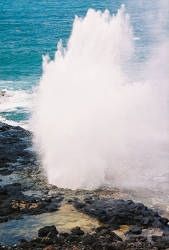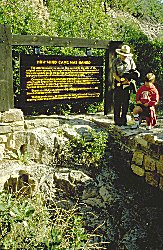Blowhole
Gloup
A blowhole is a hole which blows, either air or water, with relatively high force. Typically, it does not blow all the time, water blowholes blow for seconds, air blowholes may blow for hours or weeks.
blowing cave.
A cave out of which or into which a current of air flows intermittently.
Watson Hiner Monroe (1970): A Glossary of Karst Terminology, Geological Survey Water-supply Paper 1899-k, Library of Congress catalog-card No. 75-607530
DOI
online
A blowhole is a cave exit, often a vertical shaft or vent, which is quite narrow. And it is typically the only exit, or there are only very few exits. The reason is, that the blow requires a high pressure inside the cave which blows out of the cave. If there are too many or too big exits, there will be no forceful blow but a calm outflow instead.
Sea Blowholes


The most common blowholes are located at the coast. They are commonly called blowholes but may also be called salt water geyser. They are formed by sea caves with a vent to the surface. The waves roll into the cave opening, and depending on the force (or size) of the wave the pressure inside the cave rises. If there is a vent to the surface the pressure will press water out of the vent.
Such blowholes blow for a few seconds, then there is a pause, probably a long pause, then they blow again. It depends on the waves, if there are high waves there will be regular blows, with no waves there are no blows. If the size of the waves differs it may blow on high waves and not on small waves.
It is quite hard to determine which kind of cave is the reason for the blowhole. If a karst area reaches the sea it might be a karst cave with a shaft, in volcanic areas it’s typically a lava tube with a vent, in reefs it often a reef cave. There is also the possibility that it’s an erosional cave or littoral cave.
- Examples
 Jacks Blowhole
Jacks Blowhole Spouting Horn
Spouting Horn Smoo Cave
Smoo Cave
Air Blowholes

Big cave systems have a big volume, and the pressure inside does not change, mostly because there are no temperature changes. Our atmosphere is different: there are temperature changes which change the volume of the air, cause convection cells and areas of high and low pressure. This produces wind. In the case of caves, this is called barometric ventilation.
If a cave is small the pressure changes outside will cause air flow in or out of the cave until the pressure inside is the same as outside. You may feel the wind at narrow passages. If a cave has a certain size and small openings, or probably only one entrance, the airflow will be much bigger, more forceful. So the amount depends on the volume of the cave, the size of the openings and the amount and speed of change in pressure outside.
If the pressure outside is lower, the air will flow out, if it is higher it will flow in. It’s much easier to sense outflowing air, because you feel the wind, smell the damp and cold air, probably you see water condensing outside forming fog. If you want an accurate number for the airflow, you must place a sensor measuring the air speed in the most narrow part of the entrance.
And a final comment on the terminology. Unfortunately common speed uses the term wind cave for such caves, numerous caves were named wind cave for this reason, in different languages, like Windhöhle or Grotta del Vento. Unfortunately the scientific term wind cave means caves which were created by wind erosion. We try to make clear what is actually meant by using aeolian cave for caves created by wind erosion and blowhole for caves which are blowing, and avoid the term wind cave as much as possible.
"Sucking" Holes
As we explained, both air and water blow out of and into caves. The emphasis is normally on blowing out, because it is easy to see or feel, for blowing in you need to measure the wind speed. With sea blowholes it is quite simple: there is a spectacular geyser blowing out of a blow hole and nothing else. There is no water which could blow in. But actually there are a few "inverse" blowholes.
Such holes are vents which are too big to be blowholes. If you look into the hole the water rises and falls inside in sync with the waves crashing at the coast. But there is nothing spectacular and no "blowing" at all.
So what we are talking about is actually a temporary situation which occurs quite seldom and looks like there is a hole where the seawater flows in and vanishes. This is in a way an illusion, as the water is just flowing back into the sea, but it looks quite spectacular. And the requirements are quite specific and thus rare. We need a platform only a few meters above the sea level, a sea cave below, and an opening from the cave to the platform. When the waves are big enough to flood the platform now or then, the water will flow back into the sea immediately. But it will also flow into the cave opening, which at the same time looks like the water is flowing away somewhere unknown. The reason is simply that we are between two waves and the water level inside the cave is sinking. It’s quite difficult to describe this, so there is a video of Thor’s Well in Oregon on youTube.
- Examples
 Mokolea Lava Pools
Mokolea Lava Pools Thor’s Well
Thor’s Well
 Search DuckDuckGo for "Blowhole"
Search DuckDuckGo for "Blowhole" Blowhole - Wikipedia (visited: 16-JUN-2020)
Blowhole - Wikipedia (visited: 16-JUN-2020) Thor’s Well (visited: 20-FEB-2023)
Thor’s Well (visited: 20-FEB-2023)
 Index
Index Topics
Topics Hierarchical
Hierarchical Countries
Countries Maps
Maps